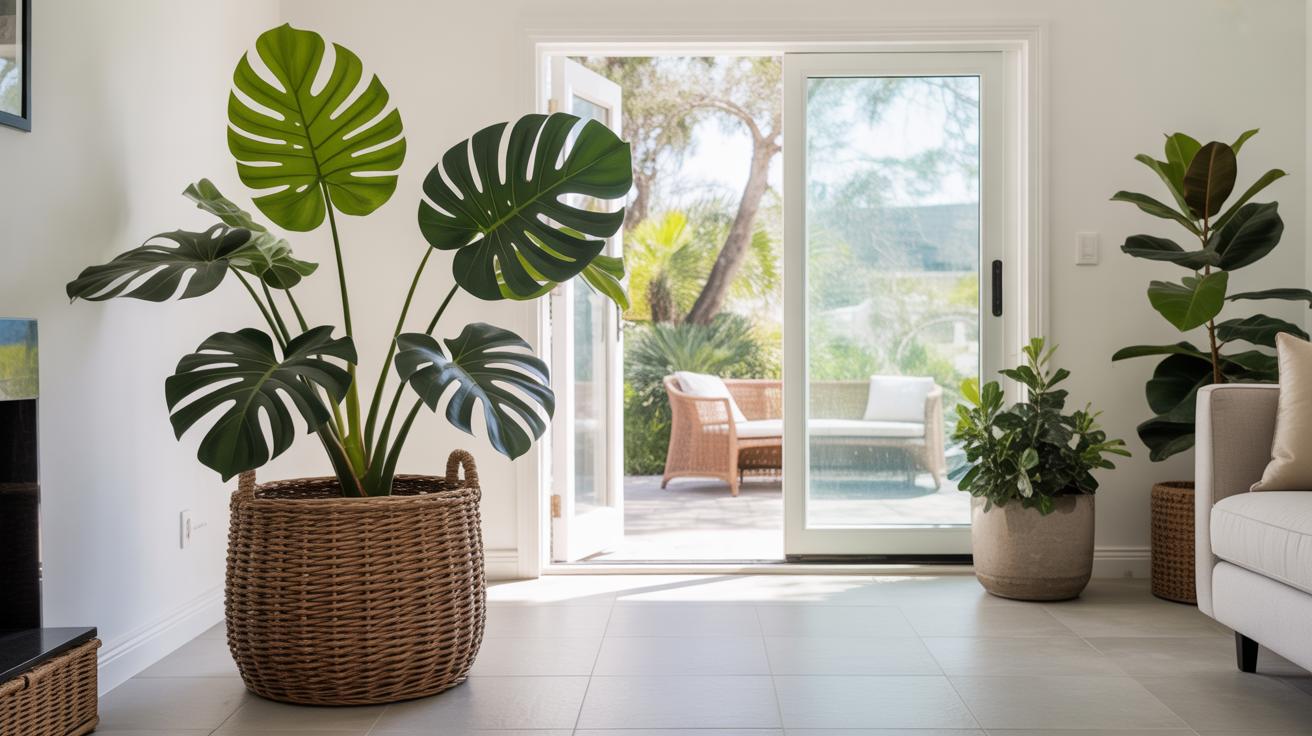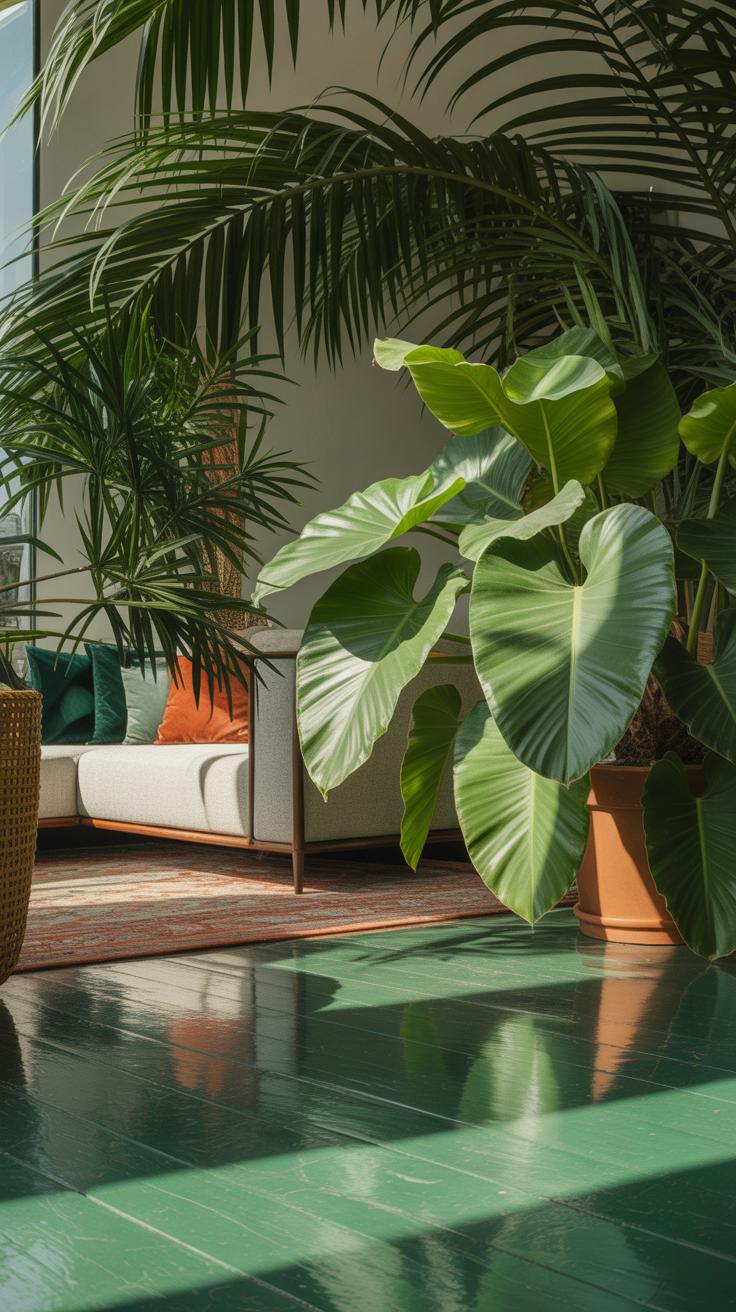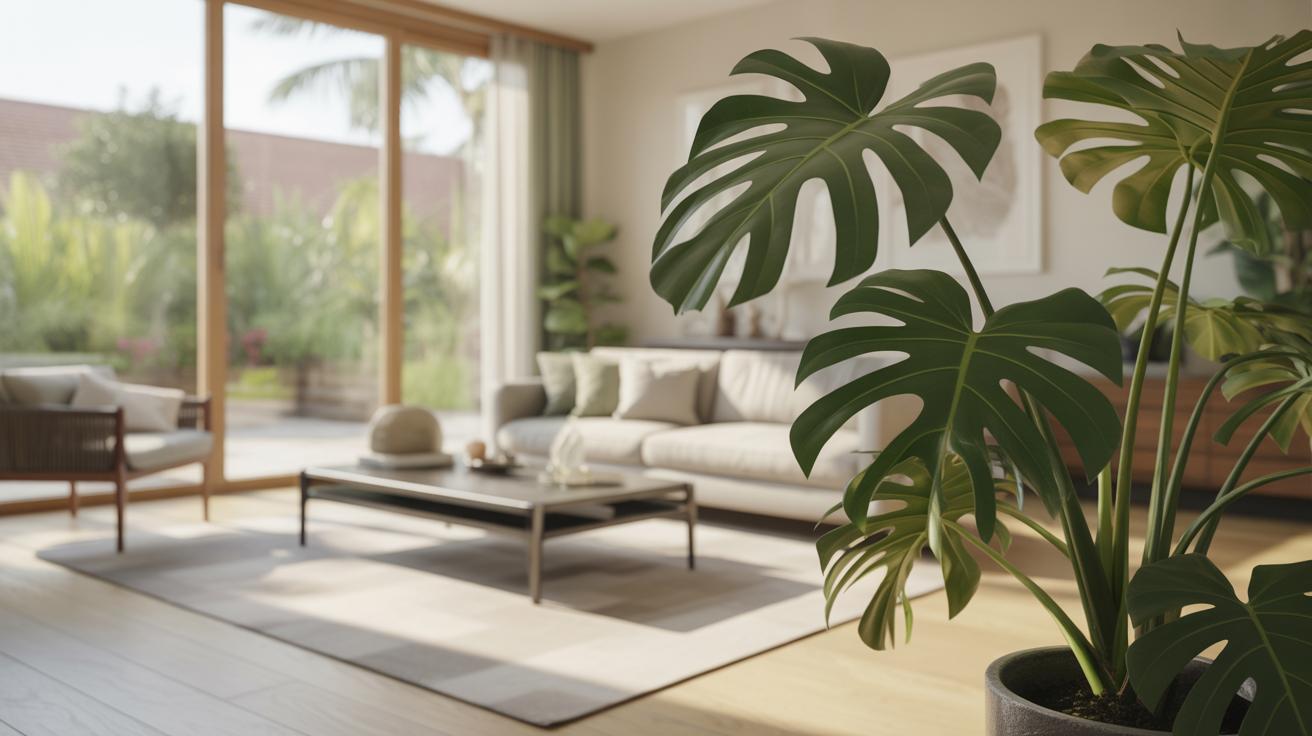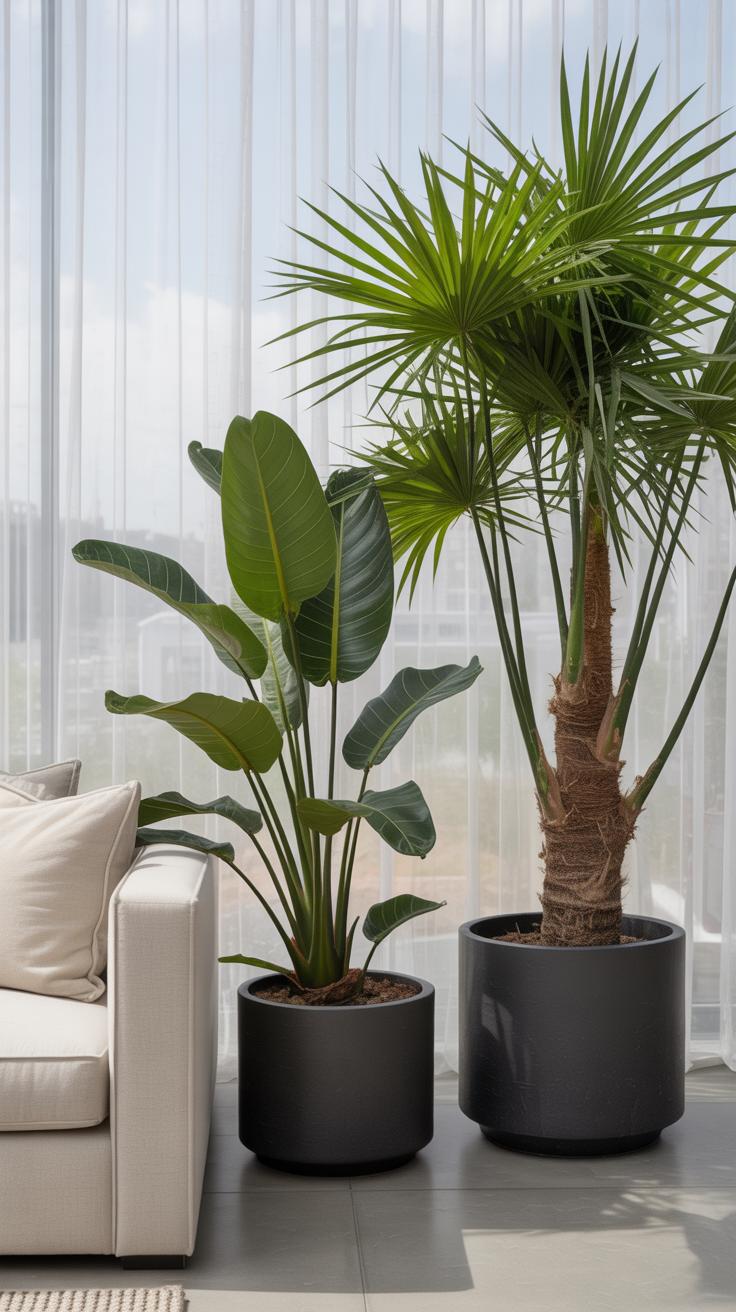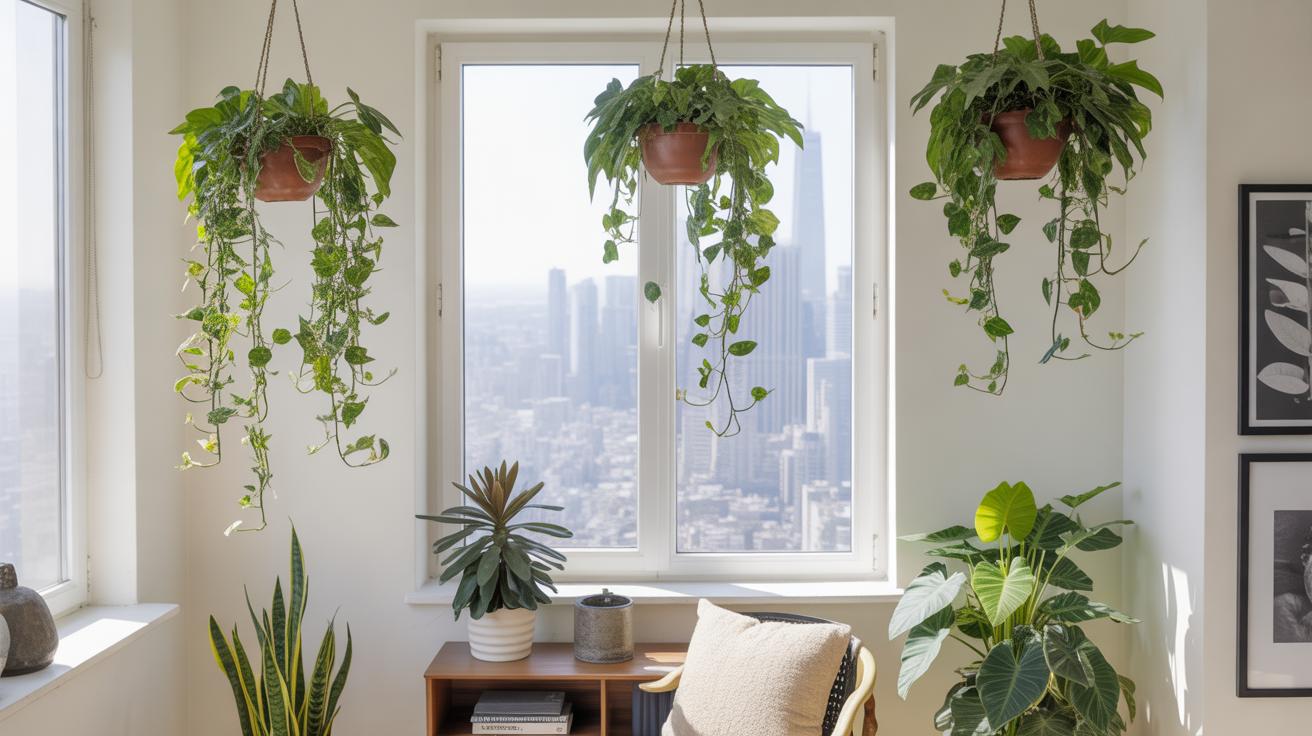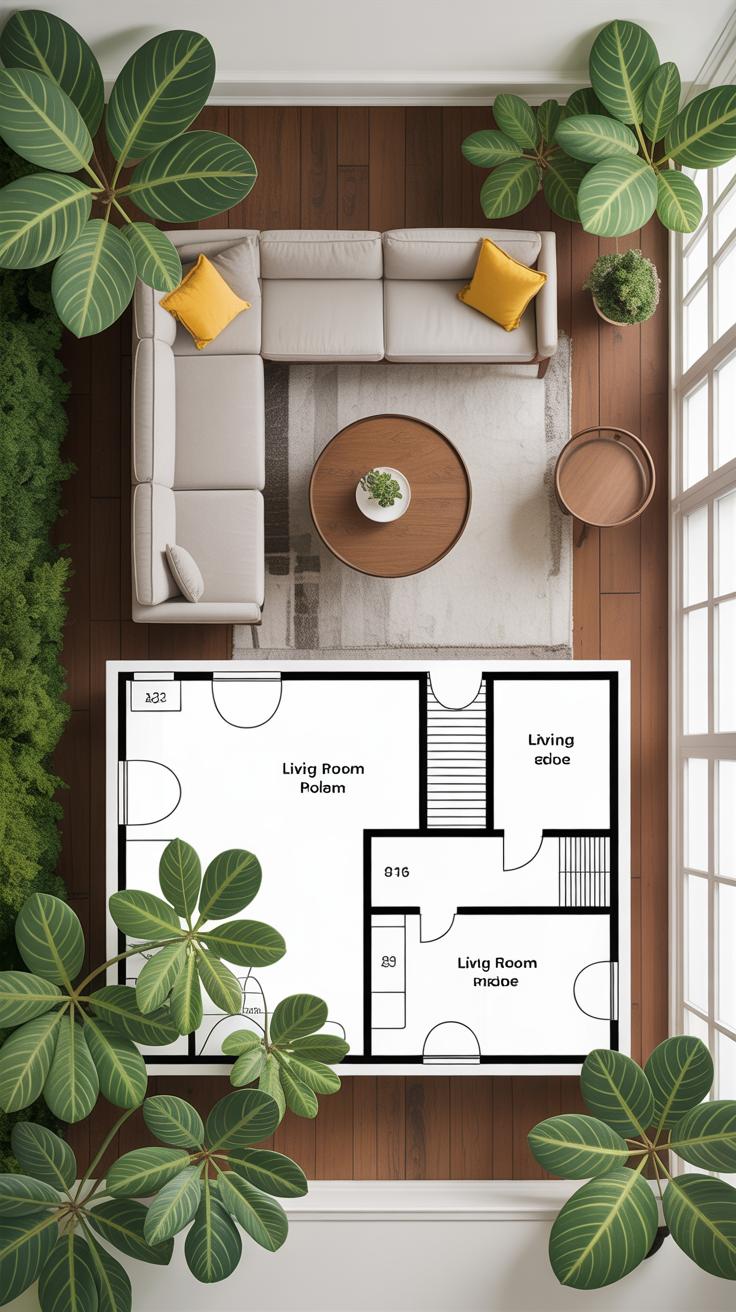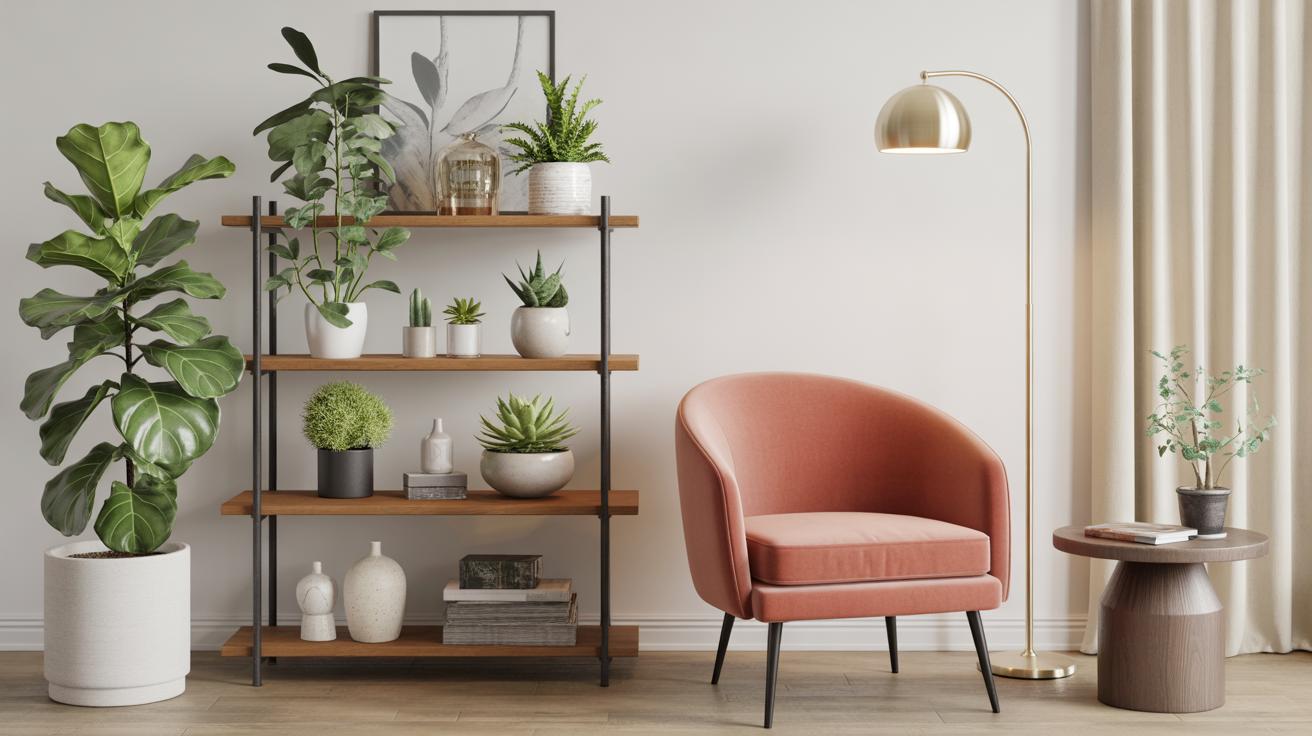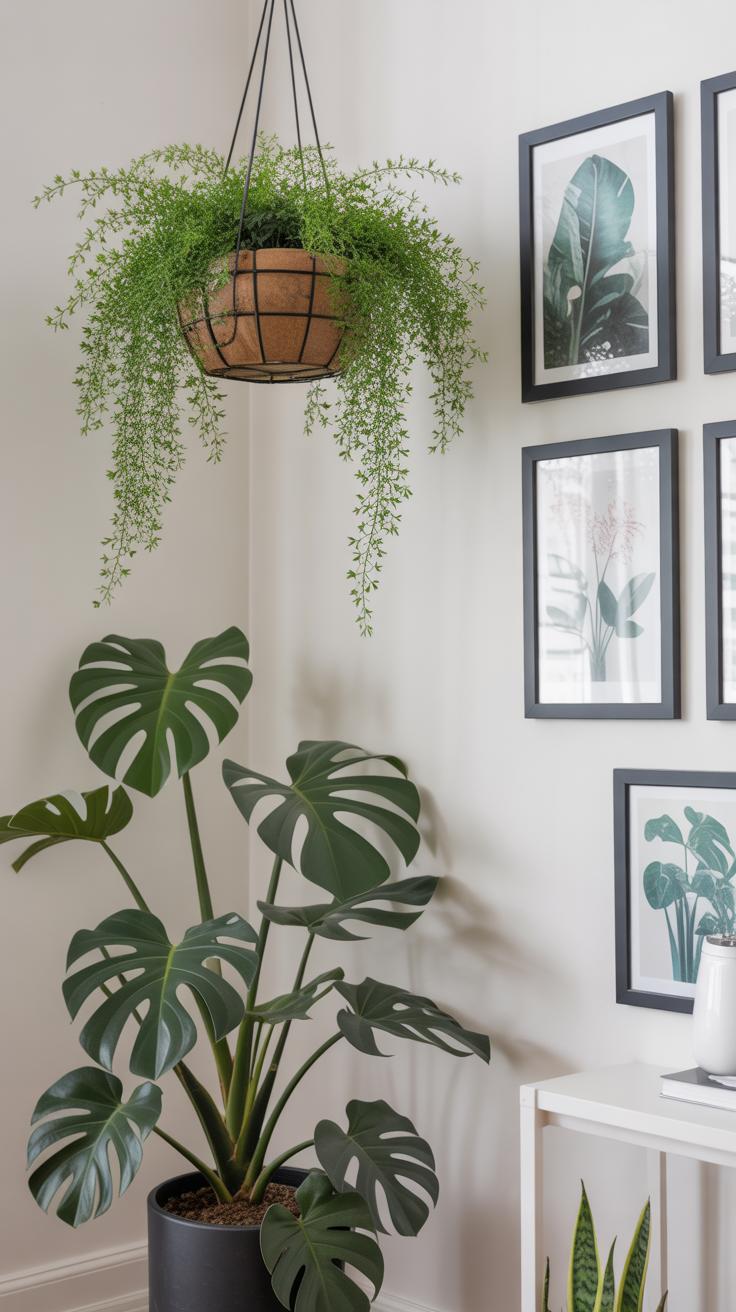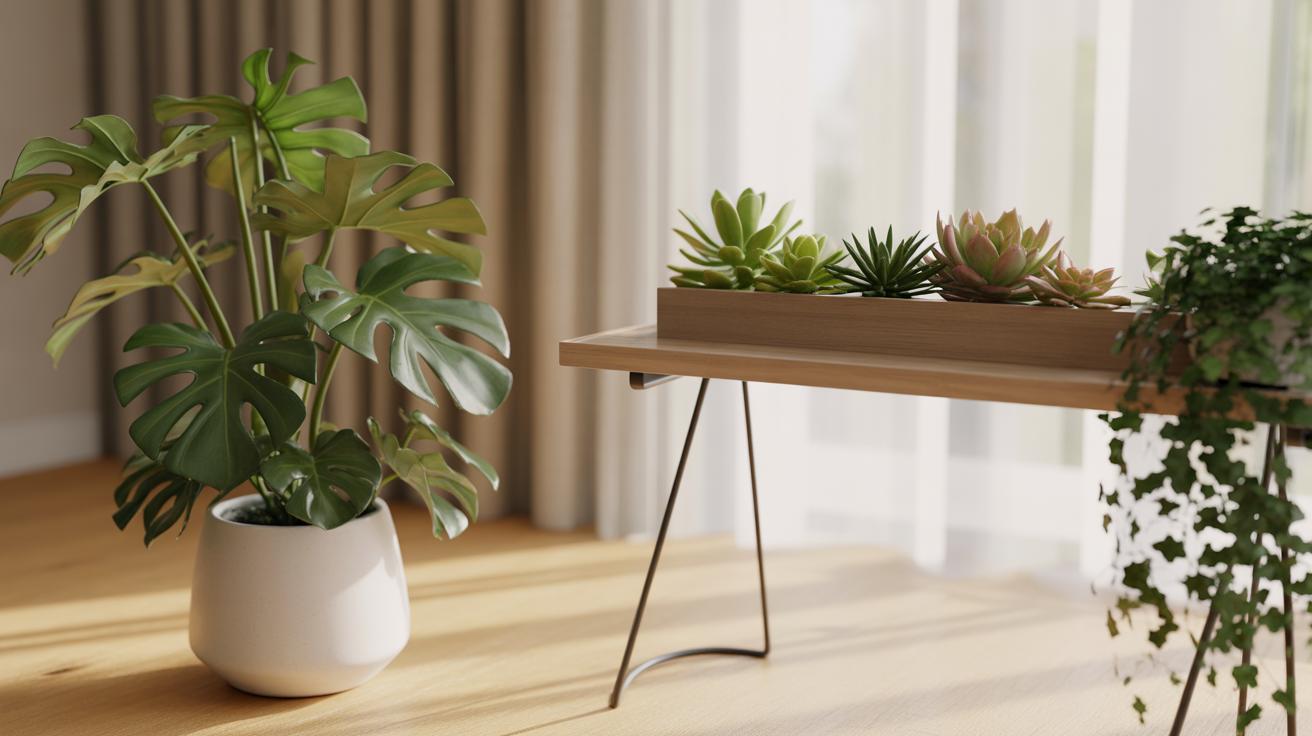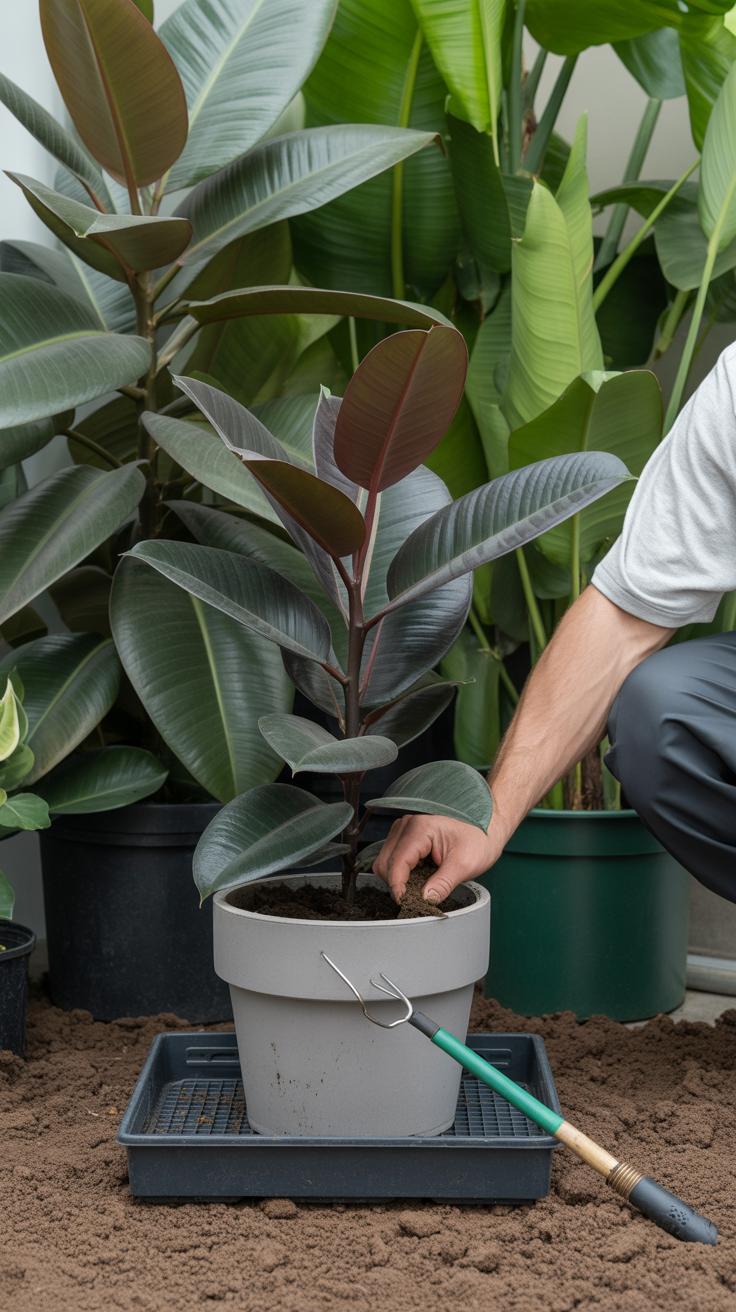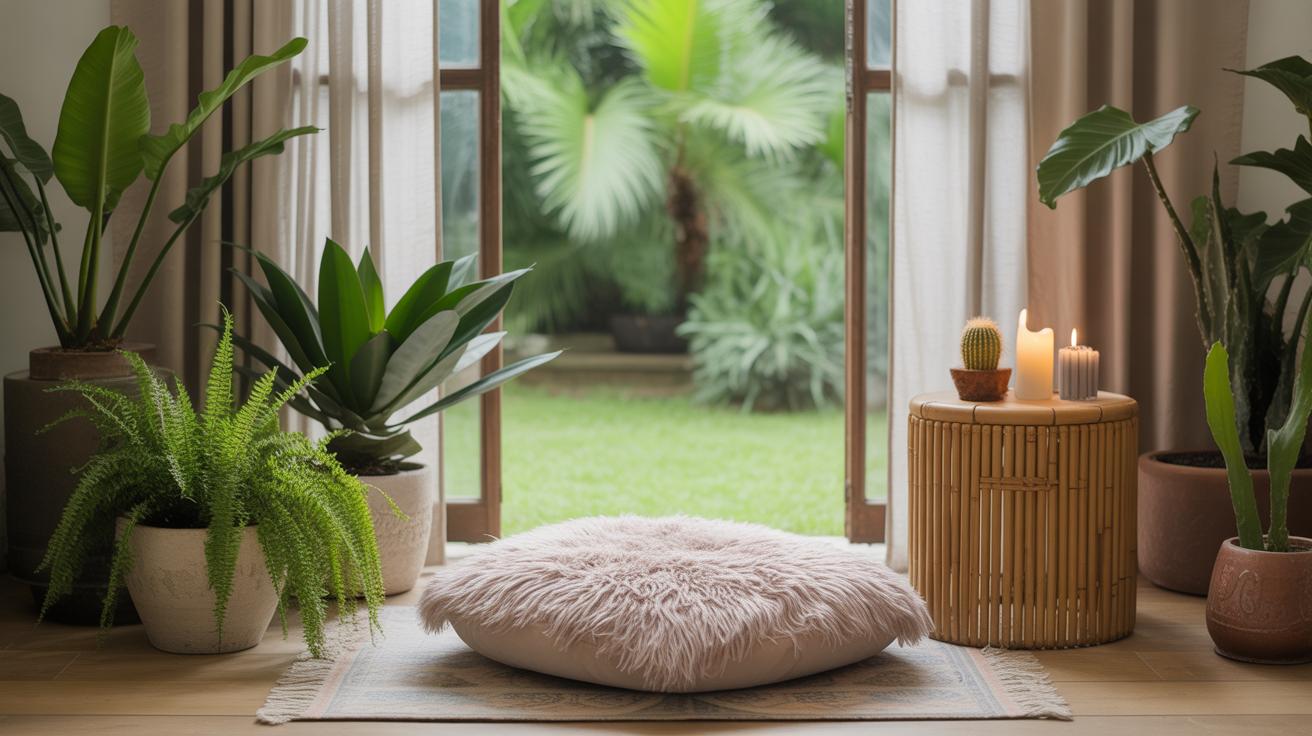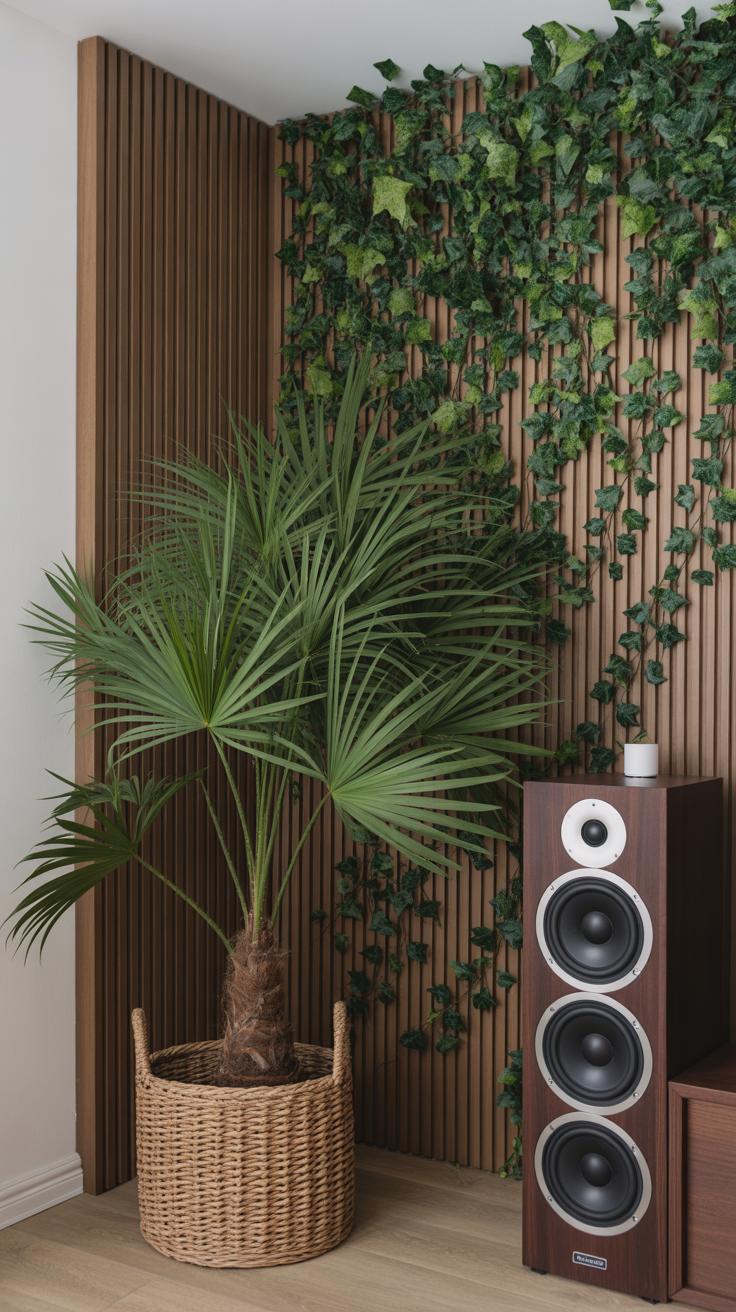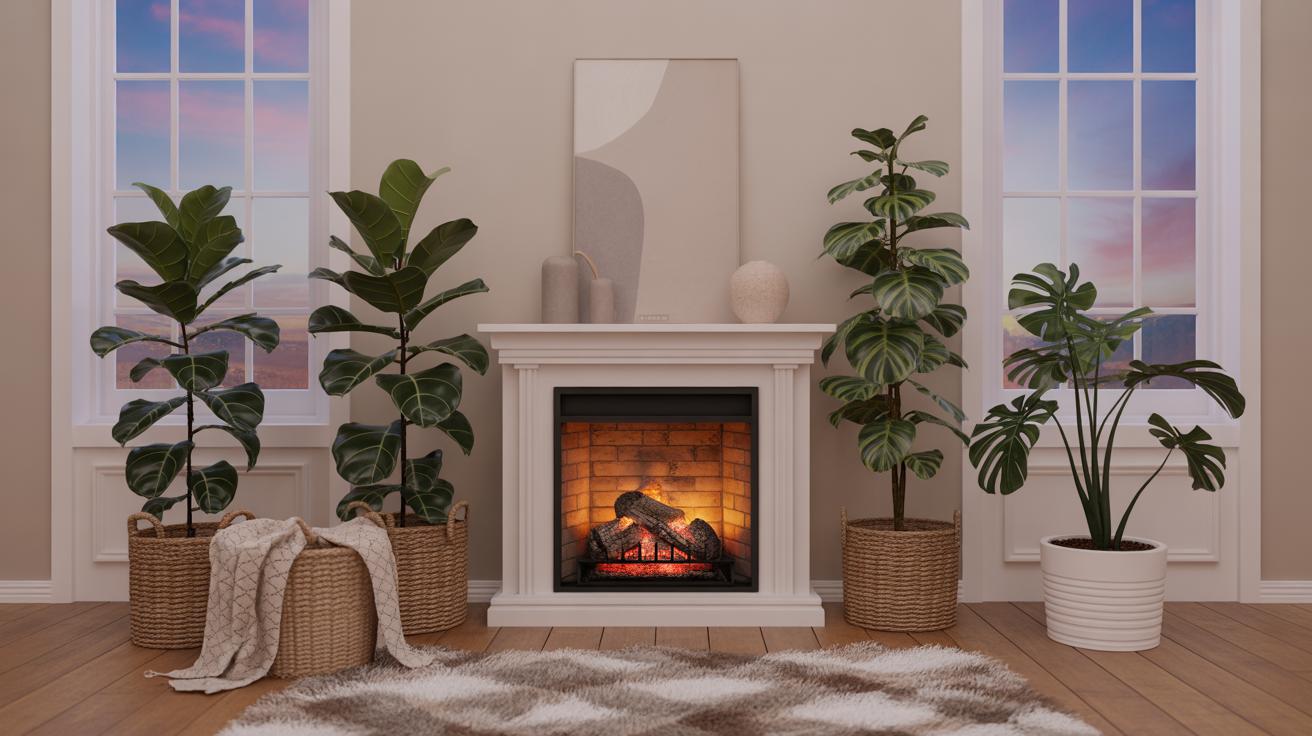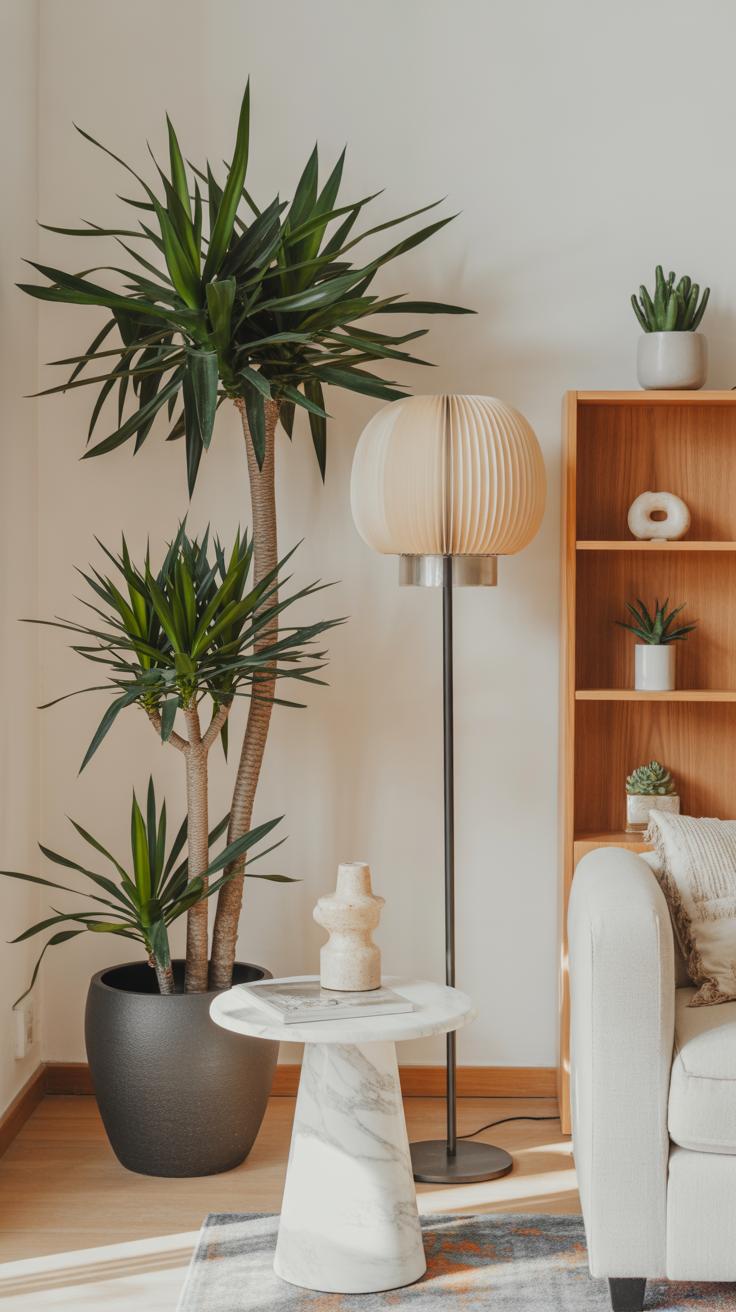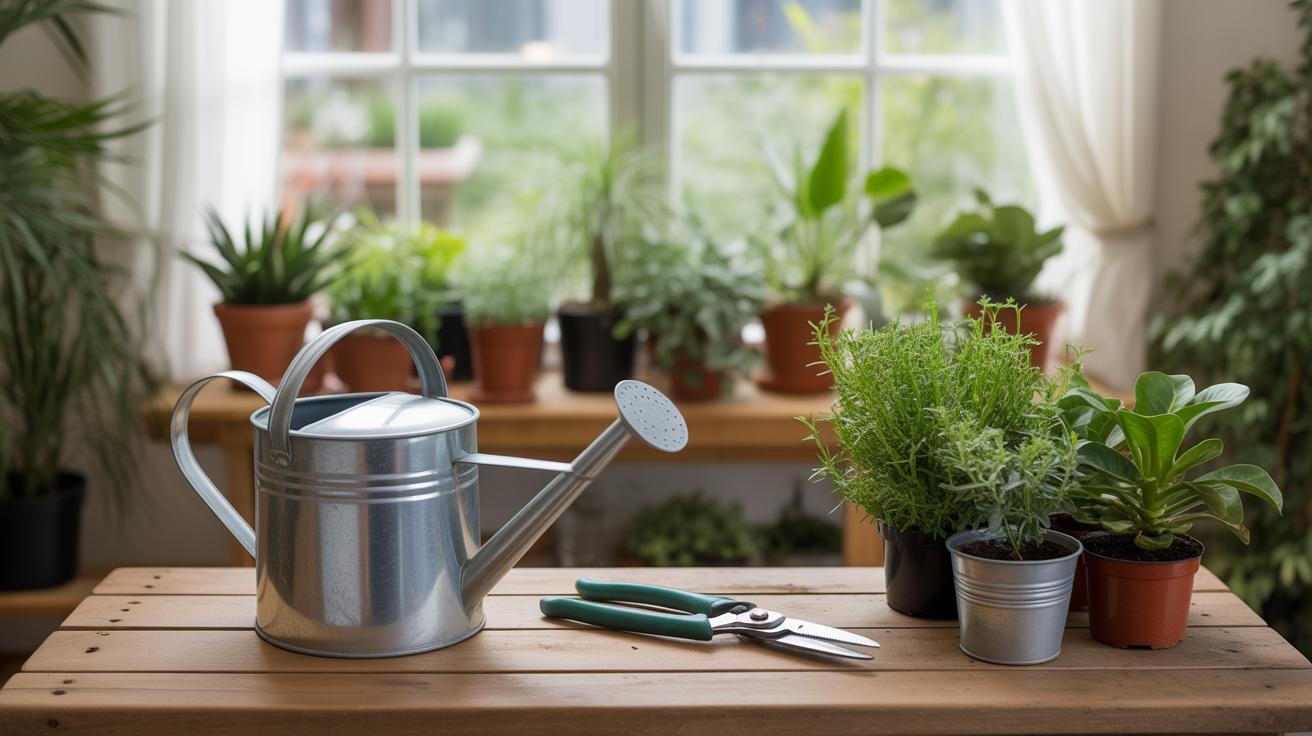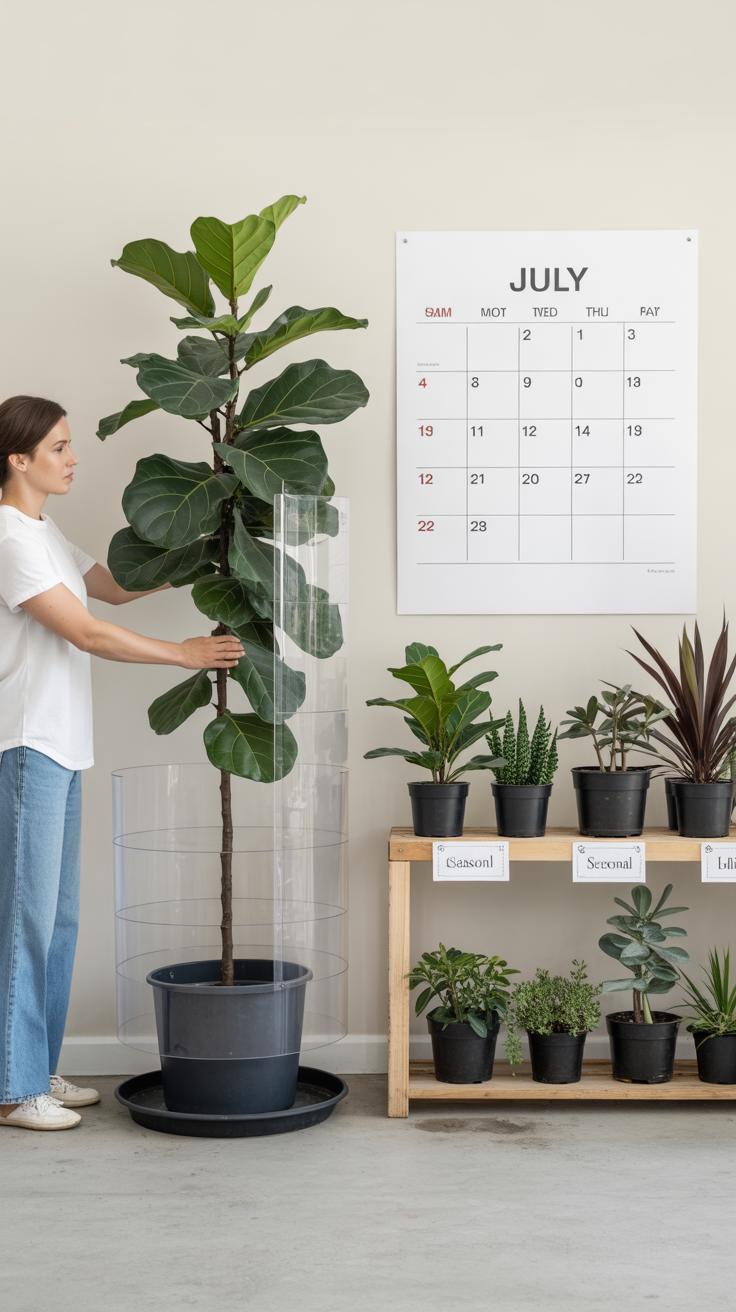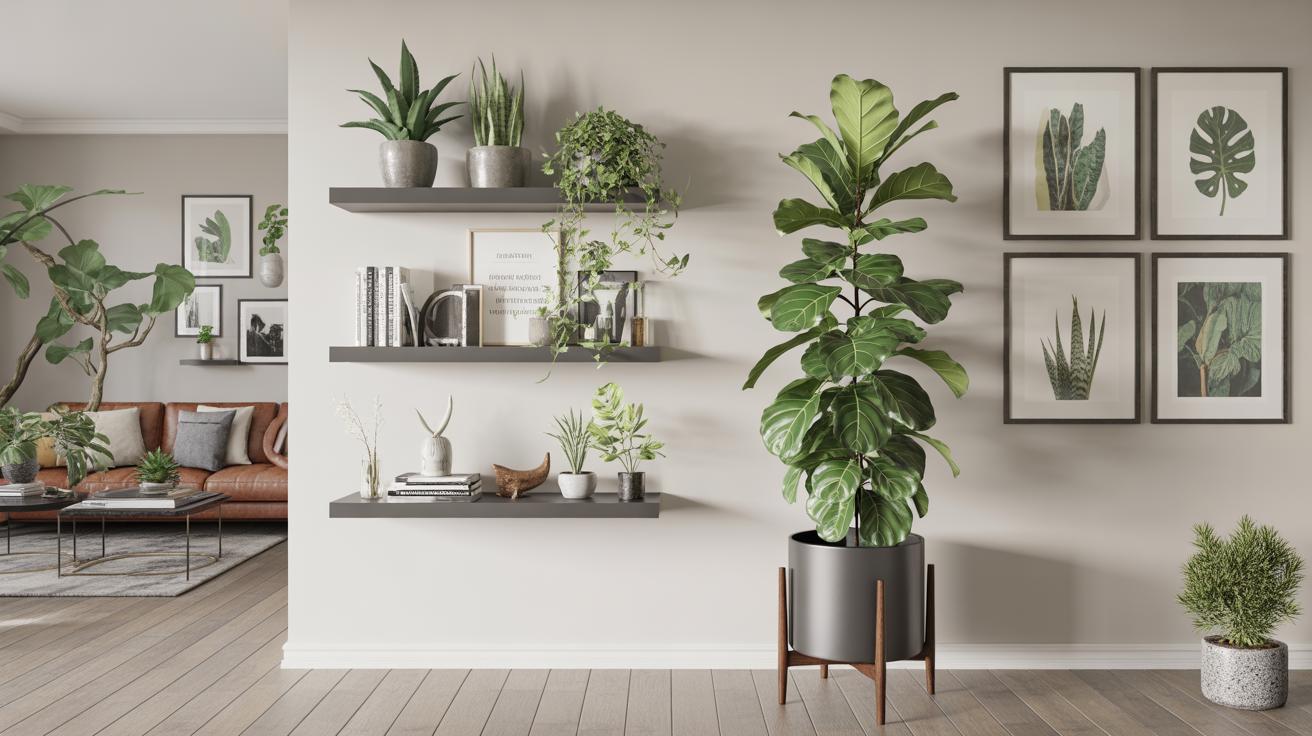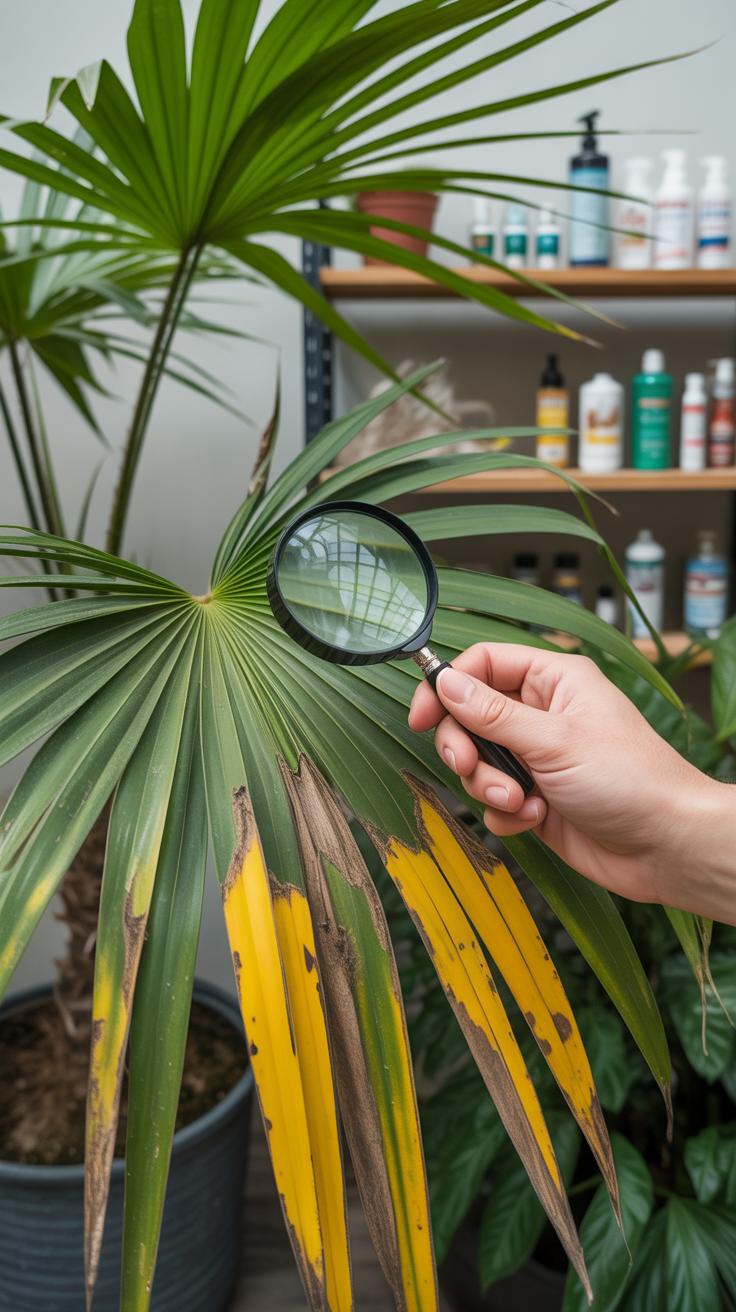Introduction
Incorporating large plants in living room layouts can transform your space. Large plants bring nature indoors, improve air quality, and create a calming atmosphere. They can act as focal points or fill empty corners, adding life and texture to your décor. Adding large plants is more than just decoration; it’s a way to connect with nature inside your home.
This article will explore practical ways to select and arrange large plants in your living room. You will learn about the best types of plants to choose, how to care for them, and creative ideas to style your space with greenery. By the end, you will have simple and effective tips to bring a fresh and inviting feel to your living room using large plants.
Benefits of Large Plants in Living Rooms
Air Quality and Health Benefits
Large plants in your living room do more than just look good; they can actually change the air you breathe. They absorb carbon dioxide and release oxygen, which helps refresh indoor air, especially in spaces that don’t get much ventilation. Some species are known to filter out common pollutants like formaldehyde and benzene, which hang around from furniture or cleaning products. It’s easy to overlook, but better air quality can mean fewer headaches, less fatigue, and even fewer respiratory problems over time.
Personally, I noticed a slight difference in how I felt spending time in a room with a big leafy plant versus an empty one. It might sound subtle, but there’s something about the presence of greenery that feels… healthier, in a physical sense. You might wonder if one plant really makes a difference—well, it depends on size and number, but large plants certainly contribute more noticeable effects than smaller ones.
Creating a Relaxing Environment
Large plants have this calming effect that’s hard to ignore. When you step into a living room with tall, lush greenery, there’s a kind of pause; it slows things down, even if just a little. Maybe it’s the way plants subtly fill empty corners or break up hard lines in a room that creates a more inviting vibe. You might find yourself sitting longer, breathing easier, or just feeling less wound up after a busy day.
Some people say plants reduce stress, and while that might sound like a general statement, there’s some truth to it. I’ve caught myself feeling less on edge when surrounded by plants—a quiet mind for a short while. But it’s not always consistent; some days I’m too distracted to notice. Still, having that green presence can help, especially when paired with soft lighting or comfortable seating. It’s worth trying, especially if you want your living space to feel less like a static area and more like a place to unwind.
Choosing the Right Large Plants for Your Living Room
Plants for Low Light Conditions
If your living room doesn’t get much direct sunlight, don’t worry—there are quite a few large plants that can manage well in those dimmer spots. Snake plants, for example, are tough and adapt to low light better than most. They don’t need fussing over, which is great if you’re not always on top of watering schedules. Another one to think about is the ZZ plant; it grows slowly but steadily without demanding much light.
Then there’s the cast iron plant. I’ve tried it in a corner with almost no sun, and it hung in there longer than I expected. It doesn’t grow quickly but maintains a nice presence. If you want a leafy option, the parlor palm works surprisingly well in shade. These plants bring life to areas where flowers wouldn’t stand a chance. Yet, keep in mind, even low-light plants need some light throughout the day—complete darkness won’t do.
Plants for Bright and Sunny Rooms
On the flip side, if your living room basks in sunlight for most of the day, you can pick plants that thrive on it. Fiddle leaf figs are quite popular; they love bright, indirect light and can really fill a space with their broad leaves. When I placed one near a sunny window, it grew so fast I had to trim it back a bit—that surprised me.
Bird of paradise is another bold pick for sunny rooms, pushing upward with big, dramatic leaves. If you enjoy a bit of color, the croton attracts eyes with its vibrant foliage and sun-fueled growth. Rubber plants also handle bright light well and develop deep, glossy leaves. But a quick thought—too much direct sun can scorch some plants, so consider a curtain or a spot with filtered rays if you’re unsure, especially midday.
Planning Your Living Room Layout with Large Plants
Placing large plants in your living room isn’t just about filling empty corners. It’s about thinking ahead—how furniture and plants interact within the space. When you plan, consider how a tall fiddle leaf fig might complement a low-profile sofa rather than compete with it. Sometimes, you might feel like the room dictates where the plant goes, but try to look at it the other way around. Could the plant anchor the seating area? Or maybe give some height near a reading nook?
Large plants can work as natural dividers, but it’s tricky. You don’t want them to feel like obstacles. Instead, imagine them as subtle boundaries—soft walls that mark different zones without closing them off. Place a broad-leafed plant between the lounge and dining spaces and notice how the flow adjusts. It’s not always neat or perfect, though. Sometimes, a plant might block a sightline a little, but that imperfection can add character.
Balancing furniture size with large plants needs some experimenting. If your sofa stretches long and low, a tall, narrow plant nearby creates contrast without overwhelm. Conversely, for chunkier armchairs, try fuller, bushier plants that match the furniture’s volume. Watch for awkward mismatches where a tiny plant fights for attention with oversized furniture—it usually just looks off. Your eye needs a resting place, and plants can provide that. But don’t feel compelled to balance every piece equally. Asymmetry can work if it feels intentional.
Creative Ways to Display Large Plants
Big plants deserve big attention. You don’t just drop them in any old container and call it a day. How you showcase a large plant can change the entire vibe of your living room. One method that I find works well is mixing pots with different textures—think concrete combined with ceramic or woven baskets holding your greenery. It creates an interesting visual contrast and makes your plant feel like part of the décor, not just an afterthought.
Pots don’t have to be boring, either. A splash of color in a muted room can wake up the space, or sticking to natural shades can help the plant blend in more subtly. Size matters too; a too-small pot looks awkward and can stress the plant, while an overly large container might overwhelm the plant’s shape. Aim for a container that feels in proportion, but maybe err a little on the side of roominess so the roots have space.
Plant stands and shelves are great tools to break up the usual floor placement. Elevating a plant can turn it into a room focal point, especially if the ceiling is high. I like using stands made of wood or metal to add some structure nearby. Shelves let you layer your plant arrangements—placing a tall plant on the floor with smaller ones above creates depth. But be careful not to crowd; plants need breathing room, literally and visually.
Here are some ideas to try out:
- Use vintage trunks or crates as unconventional plant stands, lending character.
- Group large plants with smaller potted plants on tiered shelves to create a mini indoor garden.
- Choose containers with subtle patterns to add texture without distracting from the plant itself.
- Place a tall plant near a natural light source and use a stylish ceramic pot to mirror room colors.
Have you thought about how a certain pot or stand might change the way your plant interacts with your furniture? Sometimes a simple shift in height or container material can make your space feel entirely different.
Caring for Large Plants in Your Living Room
Watering Tips for Large Indoor Plants
Watering big plants indoors isn’t always straightforward. It’s tempting to just pour water until the soil is soaked, but that can cause more harm than good. A better approach is to check the soil moisture before watering—stick your finger about an inch or two deep. If it feels dry there, it’s time to water. Otherwise, wait a bit longer.
Large plants might need more water overall, but they usually absorb it more slowly. So, slow and steady wins here. For example, a tall fiddle leaf fig might only need watering once a week, but if your home is dry, you might have to water more often. Watch your plant’s leaves—they can tell you when they’re thirsty or overwatered.
Drainage is key. Make sure pots have holes and let excess water escape; it keeps roots happy. I’ve seen friends overwater their monsteras until roots started rotting—something you want to avoid.
Light and Fertilizer Needs
Lighting large plants means finding a balance between too little and too much. Most big indoor plants thrive in bright, indirect light. Placing them near an east- or west-facing window often works well. But some giants, like a rubber tree, can handle a bit of direct sunlight while others might scorch.
Think about turning your plant occasionally to promote even growth. It’s a small step that can make a noticeable difference. If natural light is minimal, consider supplementing it with a grow light. Sometimes, even large plants struggle in dim rooms.
Fertilizing doesn’t have to be complicated. Use a balanced, water-soluble fertilizer every month during the growing seasons—spring and summer—then dial it back in fall and winter. Too much fertilizer can cause burned leaves or weird growth, so less is often safer. I’ve learned this the hard way with my snake plant.
Using Large Plants to Improve Living Room Acoustics
Large plants do more than just bring life and color to your living space. Their broad leaves and dense foliage can muffle sounds, making your room feel quieter and more comfortable. Have you noticed how rooms filled with hard surfaces – like glass, wood, or tile – tend to echo? Big plants help break up that echo by trapping and absorbing sound waves.
Absorbing Sound with Plant Leaves
It’s pretty interesting how leaves, especially thick and layered ones, act like tiny sound absorbers. When sound hits the foliage, some of the noise gets trapped between leaves and stems rather than bouncing around the room. The irregular shape and texture scatter sound waves, minimizing harsh reflections. You might think, “But how much sound can a leaf really soak up?” Surprisingly, when enough leaves collect in one spot, the effect is noticeable, especially in spaces with hard floors or bare walls.
Positioning Plants to Block Noise
Placing large plants near windows or areas where external noise seeps in can actually reduce how much noise makes it inside. For example:
- Positioning a tall fiddle leaf fig or rubber plant by a noisy window can soften outside sounds.
- Grouping several dense plants near a door or noisy corner creates a natural sound barrier.
- Even shelving units with plants scattered in can help break up sound pathways.
Sometimes it’s about trial and error. I once moved a large monstera closer to a street-facing window and noticed the morning traffic sounded less intrusive. It’s not about making a room silent but more about reducing that sharpness or tinny echo. So, when you’re arranging large plants, think beyond just the look—consider how they can act as natural sound buffers too.
Mixing Large Plants with Other Decor Elements
Bringing large plants into your living room isn’t just about placing a pot in a corner. The way you pair them with furniture, artwork, and lighting can shape your entire space—sometimes in subtle ways you wouldn’t expect. When it comes to furniture, think about scale and style. For instance, a chunky mid-century modern sofa might feel off if paired with a delicate tall fern. But a fiddle leaf fig or monstera with broad leaves? That can anchor the space nicely, almost like a living sculpture beside sturdy wood or metal frames.
On the flip side, contrasting plant styles with your furniture can also work, but you need to be careful it doesn’t turn chaotic. Imagine a sleek, minimalist couch next to an unruly, sprawling palm—it might add interest, but it could also feel unbalanced or distracting.
Artwork and lighting play critical roles here too. Positioning a large plant near a softly lit wall art piece can focus attention on both elements, creating a kind of dialogue in the room. I’ve found that warm, directional lighting—like a spotlight or track light angled at your plant—does more than just show it off; it adds depth and highlights textures in the leaves and pot, making the plant part of the artwork rather than just background greenery.
Keep in mind few rooms can support a perfect match between all elements. Sometimes your living room might lean more on the harmony side, other times on contrast. The key is in observing how the plant interacts with the room as a whole—does it feel like a natural part of the setup or more like an afterthought? Experiment with moving plants around, shifting artworks, and testing different lighting angles until you find what pleases your eye. I’ve often changed positions several times just to get a feeling right.
Seasonal Care and Rotation of Large Indoor Plants
Large indoor plants don’t stay the same all year round, so your care routine needs some tweaking as seasons change. For instance, during winter, sunlight dims and temperatures drop indoors, which means your plant might need less water but possibly more light. In summer, bright light is abundant, but the air can get dry, so you often need to increase watering and maybe mist the leaves now and then.
Moving large plants around the room isn’t just about aesthetics. Sometimes, shifting a plant closer to a window during darker months helps it soak up what little light is available. When spring arrives, it might be good to rotate your plant to encourage even growth; otherwise, it could lean awkwardly toward the light, making it top-heavy or unbalanced.
Try to watch for signs your plant is unhappy in its spot—like droopy leaves or fading color. It might be time to relocate it, or adjust the watering routine. I found once that moving my fiddle leaf fig just a few feet away from the window made a huge difference in its resilience through winter. The idea is to stay flexible, not set in stone. After all, every living room and plant combination is a bit different.
Troubleshooting Common Issues with Large Living Room Plants
Identifying Plant Pests and Diseases
Large indoor plants sometimes attract unwelcome guests. Spider mites, aphids, and scale insects often appear on leaves or stems. Look closely for tiny webs, sticky residue, or discolored spots—these are clues pests leave behind.
Fungal infections can cause spots or patches that seem odd at first. Powdery mildew looks like a white dusting, while root rot might make your plant wilt without obvious leaf damage. Don’t overlook yellowing leaves—they might signal mold or nutrient problems but could also hint at hidden pests.
Simple Solutions to Revive Your Plants
If your plant seems sick, start by isolating it. Give leaves a gentle wash with soapy water to remove many common pests. For stubborn insects, insecticidal soap or neem oil can help, but test a small leaf first—it’s tricky with sensitive plants.
Yellow leaves often confuse many owners. Usually, trimming the damaged parts and adjusting watering habits improves health. Too much water suffocates roots; too little leaves them hungry.
Slow growth? Try checking if your plant’s light needs are met. Sometimes, a simple move closer to a window makes all the difference. Fertilizing lightly during growth periods might revive a sluggish plant too, but don’t overdo it.
Patience also matters—a plant won’t bounce back overnight. Watch for small improvements and keep adjusting care steps. It’s a bit like coaching a shy friend; you learn what works by trying and observing.
Conclusions
Large plants can bring many benefits to your living room. They create a relaxing environment and improve the overall look of your space. Choosing the right plant for your conditions and arranging them thoughtfully will help you enjoy plants in your home without stress.
Try adding large plants in different corners or near windows to make your room lively. Caring for these plants regularly keeps them healthy and beautiful. Remember, a little effort to incorporate greenery can make your living room comfortable and welcoming.

